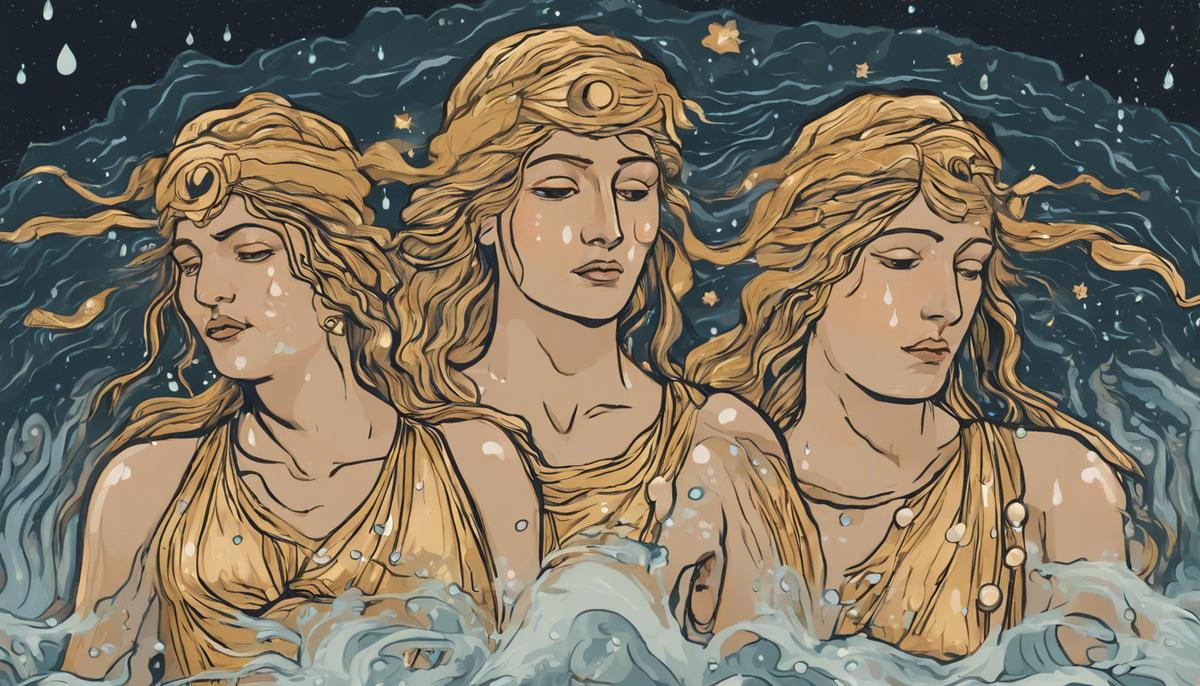Origins and Family
The origins of the Hyades are as clouded as the rainy seasons they bring. Most Greek myths say these nymphs were daughters of Atlas, the Titan holding up the sky, and Pleione, an oceanid known for protecting sailors.
The Hyades were sisters to the Pleiades, another star cluster, born from the same Titan-Oceanid union, filling the sky with starry relatives.
Myths differ on their parentage. Some name Oceanus, the earth-encircling fresh-water stream; Melisseus, possibly reflecting a princely authority tied to beekeeping; or Cadmilus and Erichthonius. These variations shift their divine standing and tease different symbolic interpretations across regions.
In a typical Greek mythical twist, after their brother Hyas died, killed by a wild animal, the Hyades were placed in the sky as stars—a celestial tribute to their grief. This transformation from nymphs to stars links natural phenomena like rain to human reactions to loss.
These narrative variations reflect diverse regional beliefs and attempts to align celestial observations with local lore.
Many sources also tie the Hyades to important earthly events. Some say they nurtured Zeus or other deities like Dionysus, highlighting their caregiving role despite their melancholy tales.
Their story is about impactful connections—linking nature to the heavens, personal loss to environmental influence. It shows their adaptability as influential presences in Greek cosmic and everyday life. This family tapestry reveals how Greek culture intermingled natural phenomena with divine responsibilities, with constellations telling tales of family ties shaping collective human destiny.
Symbolism and Cultural Significance
The Hyades, as "rain-bringers," have a deep relationship with the cycle of growth and renewal—a role that beautifully combines femininity with nature's rhythms. Ancient Greeks saw these patterns not just as weather, but as divine acts woven into life itself.
Embodying such myths through female forms—nurturing and goddess-like—shows how Ancient Greeks valued femininity. The Hyades were keepers of life's cycles, representing both the pain of loss (through their tears for Hyas) and the constant nourishment of the earth. While mournful in the heavens, they also symbolize rejuvenation and feminine control over natural forces.
More than nymphal metaphors, these celestial muses painted a world where divine figures influence nature. Rain, brought by the Hyades, was an event full of supernatural meaning, elevating femininity to god-like roles. Their tales as nurturers of gods like Zeus and Dionysus show womanly figures at the heart of divine caregiving—blending myth, theology, and meteorology.
In pagan traditions deeply tied to earth and sky, stories like the Hyades' help explain the unpredictability of nature, managed through tales of gods and nymphs. They play key roles in this vital storytelling—embodying nurturing yet powerful aspects, linking mythical female powers to real-world phenomena.
So, in the grand tapestry of Ancient Greek star lore, the Hyades' myths unfold like soothing rain—a symbolic panorama steeped in nature, brimming with feminine divine essence, shaping humankind's understanding of their place in nature's cycles while celebrating the all-encompassing spirits of ancient goddesses.

Mythological Tales and Transformations
In the vivid world of Greek myth, the Hyades' story shines with transformative sorrow. Tragedy strikes when their brother Hyas is killed by a wild animal—a brutal twist of fate shattering their celestial harmony.
The Hyades, consumed by grief, turned their essence into endless tears—tears that didn't just fall, but shrouded the skies, manifesting as ceaseless rain on the earth below. It's a tale filled with the drama of mourning heavens, where personal loss becomes a universal phenomenon.
Zeus, moved by their sorrow or the sheer poetry of it, placed them among the stars. Now, as the star cluster we call the "Hyades," these nymphs grieve eternally in a tableau both starkly somber and hauntingly beautiful, painted across the night sky.
This part of the tale illuminates a captivating theme in ancient lore—the idea that death brings not an end, but a transformation into ever-present guides of both sea and spirit. It's as dramatic as it is rich in meaning, showing how the afterlife makes beings into eternal guideposts.
Within these age-old stories lies both a warning and a lesson. As the Hyades brought rain with their rising and setting, hinting at predictable seasonal patterns tied to celestial movements, they also wove into humanity's star-gazing something less practical, more poetic—constant reminders of the link between the cosmos and human emotion.
Such folklore creates connections deeper than just cause and effect or divine family trees. It encourages empathy—a primal understanding that our own emotional depths reach far beyond us, projecting onto the constellations twinkling above. The luminous threads of legends like the Hyades' remind us to look up and within, intertwining ancient wisdom with modern thought.
And so, under this mythic light—with grief etching constellations and sorrow nurturing the earth—the Hyades eternally draw our gaze skyward. Through timeless dialogues sparkling across eras and emotions forever fixed in the firmament, they endlessly remind us that myth endures, binding mortal hearts to immortal cycles—the deepest truths merging personal stories with universal symbols.
The Hyades' Role in the Pantheon
In the vibrant tapestry of Greek mythology, the Hyades—those nurturing, celestial nymphs—find their place in the pantheon not just through family ties, but through deeds that define divine caregiving amidst the drama of the gods. Their role is clearest in their link to Dionysus, god of wine, revelry, and the life-giving harvest.
The act of nourishing Dionysus gives the Hyades a significance beyond mere rain-bringers. In his infancy, Dionysus was vulnerable to the vengeful wrath of Hera, jealous wife of Zeus. The gentle Hyades stepped in as nurses, protecting the young god. This nurturing role granted these tearful nymphs a place of honor in the sphere of fertility and care, typically ruled by goddesses like Artemis and Demeter.
Through this tender act, Dionysus' realm became indebted to these guardian spirits, who watch over the borders between intoxication and far-reaching fertility. In festivities, art, and theater tied to Dionysus, the Hyades' influence is felt, their celestial tears nurturing the vines and the passions they embody.
The fervent link between misty skies bringing water to the earth mirrors the nurturing bond—a vision of humble yet essential power etched in stardust, shaping the very foundations of the mythical world.
Even the great Zeus, moved not just by need, but by the depth of their devotion, gave them a place of honor in his vast schemes—raising them to the stars as matrons and guides.
Their role in the pantheon is a vital one, manipulating not just the rains but the very cycles of nature and civilization. They are watchers, weavers, conduits between the celestial and the earthly, their essence flowing from the heavens to nourish the roots of life itself.
In every glimmering drop of dew, in every swell of the harvest, in every story passed down through the ages, the Hyades are there—shimmering threads in the grand mythology tapestry, forever binding the tears of the sky to the blooming of the earth. They are nurturers supreme, their myth an enduring reminder of the sacred bond between sorrow and renewal, immortality and the eternal cycles that sustain us all.

- Apollodorus. The Library, Book 3. Translated by Sir James George Frazer, Loeb Classical Library Volumes 121 & 122. Cambridge, MA, Harvard University Press; London, William Heinemann Ltd. 1921.
- Hesiod. The Homeric Hymns and Homerica. Works and Days. Translated by Hugh G. Evelyn-White, Loeb Classical Library Volume 57. Cambridge, MA, Harvard University Press; London, William Heinemann Ltd. 1914.
- Hyginus. Astronomica. Translated by Mary Grant. Theoi Classical Texts Library. 2017.
- Ovid. Fasti. Translated by James G. Frazer. Loeb Classical Library Volume. Cambridge, MA, Harvard University Press; London, William Heinemann Ltd. 1931.

Leave a Reply